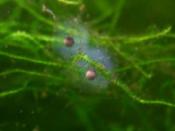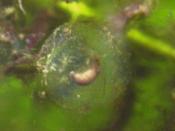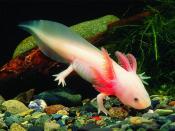AMPHIBIA: CAUDATA: AMBYSTOMATIDAE AMBYSTOMA MEXICANUM _______________________________________________________________________________________________________
�
Catalogue of American Amphibians and Reptiles.
Amelingmeier, Amber. 2008. Ambystoma mexicanum.
Ambystoma mexicanum
Axolotl, Mexican Salamander, Mexican Walking Fish
Ambystoma mexicanum . Shaw, 1789.
"Holotype: BM, according to Smith and Taylor, 1948, Bull. U.S. Natl. Mus., 194: 8, but not there now. Type locality: given both as "Mexicanum" and "Mexico"." (Frost, 1985)
Content. One genus, Ambystoma, with 30+ species.
(Zug, Vitt, and Caldwell, 2001)
Definition. Adults range in length from 6-18 inches (15-45cm), a size ranging up to 9 inches (23 cm) is common but greater than 12 inches (30 cm) is unusual. Axolotls have external gills as well as a caudal fin extending from behind the head to the vent. Their heads are usually wide, and their eyes are lidless. Their limbs are underdeveloped and have long, thin digits. Males are easily identified by their swollen cloacas lined near the papillae, while females are obvious for their broader bodies which are filled with eggs.
There are three pairs of external gill stalks begin behind their heads which are used to move the oxygenated water. Axolotls have hardly visible vestigial teeth which possibly developed during metamorphosis. The primary method of feeding is through suction, where their rakers connect to close off the gill slits. There are four different colors within the Axolotls, two naturally occurring colors and two mutants. The varying shades of brown usually with spots are the two natural colors, which are the wild type and melanoid whom are black. The leucistic which is pale pink with black eyes and albino being golden, tan or pale pink with pink eyes are the other two mutant colors (Duellman & Trueb, 1994).


